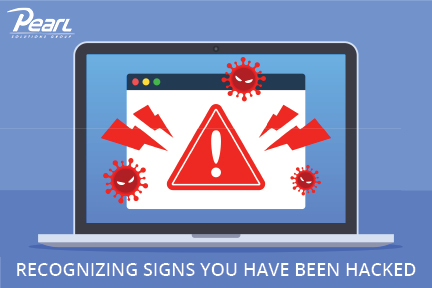According to the 2023 Business Impact Report, conducted by the Identity Theft Resource Center (ITRC), a staggering 73% of small business owners and leaders reported experiencing data breaches or cyberattacks in the past year, marking a significant surge in incidents. There is NO SUCH THING as being too small, in fact, small businesses are growing in appeal as prime targets for cybercriminals. It is critical to have a strong security posture which includes being able to quickly identify signs you have been hacked.
My website says what?!?! Website defacement is a type of cyber attack in which an attacker gains unauthorized access to a website and alters its content. This can be achieved through various means, such as exploiting software vulnerabilities, weak passwords, or insecure configurations. Once access is gained, attackers modify the website’s content in some way including replacing the homepage with a defacement page, altering text or images, or inserting malicious content.
You can avoid website defacement through typical maintenance and security measures including regularly updating and patching software, using strong, unique passwords and implementing MFA, performing regular security audits and penetration testing, employing web application firewalls (WAFs) to filter and monitor HTTP traffic, and backing up website content regularly to facilitate quick recovery.
- If your site is hosted or maintained by an external party, notify them as soon as possible and have them take the necessary steps to remediate the problem.
- Reset all passwords to website administrator accounts.
- Replace all files located on the website server with files from an isolated or standalone backup source.
- Consider temporarily removing or quarantining your website until the situation has been rectified and all website links created by the hacker have been removed.
My computer is SOOOO slow! While we normally think a slow computer is from aging hardware or poor connectivity, in some cases, a slow computer may be a sign of a cyber attack. Malware, viruses, and network attacks could contribute to a slowdown in your computer’s performance. Malicious software, such as viruses, spyware, or adware, run in the background without your knowledge, performing tasks that strain your computer’s capabilities. In a DoS attack, the attacker overwhelms a system with a flood of traffic, making it difficult for legitimate users to access resources. Some attacks are designed to exhaust your computer’s resources, such as CPU, memory, or disk space.
- Notify IT immediately if you suspect your computer has been compromised.
- Run anti-virus and anti-malware scans to detect and remove malicious programs.
- Use network monitoring tools to keep an eye on your network traffic and isolate breaches as soon as possible.
- Make sure your operating system, anti-virus software, and all other applications are up-to-date with the latest patches.
- Configure your firewall and security settings to block unauthorized access and suspicious activities.
Hello? Is anyone there? If you start to notice a lack of replies to emails, are getting reports of missing emails, or your emails are all bouncing back as spam, you may have been breached. Email cyber attacks can take various forms, and one common type involves attackers gaining unauthorized access to your email account and altering its configuration for malicious purposes.
- Phishing: Attackers may use phishing emails or messages to trick users into providing their login credentials. These phishing emails often appear legitimate, containing links to fake login pages that capture the entered information. Once attackers obtain login credentials, they can access the email account and make changes to its configuration without the user’s knowledge.
- Credential Stuffing: Attackers use previously stolen username and password combinations to gain unauthorized access to various accounts, including email accounts where users have reused passwords. If a user has reused passwords across multiple accounts, attackers can use compromised credentials to access the email account and manipulate its configuration.
- Man-in-the-Middle Attacks: Attackers intercept communication between the user and the email server, allowing them to manipulate the email configuration or gather sensitive information. Attackers can alter email settings, redirect emails, or even modify the content of messages. This can lead to unauthorized access and potential data breaches.
- Malware and exploits: Malicious software or exploits can be used to compromise the security of an email client or server, allowing attackers to modify configurations. Attackers may change email forwarding rules, filter settings, or authentication methods, leading to unauthorized access or disruption of email service.
- Insider Threats: Malicious insiders with access to email configurations may abuse their privileges to make unauthorized changes. Insiders can alter email settings to facilitate data exfiltration, unauthorized access, or other malicious activities.
- Business Email Compromise (BEC): Attackers compromise email accounts, often through phishing, and then use them to conduct fraudulent activities or manipulate configurations. BEC attacks can result in financial losses, unauthorized access to sensitive information, and damage to an organization’s reputation.
To mitigate the risk of email configuration attacks, users and organizations should employ security best practices such as using strong, unique passwords, enabling two-factor authentication, regularly updating software and security patches, and educating users about phishing threats. Additionally, monitoring for unusual email activities and implementing security measures to detect and respond to unauthorized access is crucial in preventing and mitigating the impact of such attacks.
These are not the only signs you have been hacked. Some smaller annoyances may also be a symptom including your device suddenly restarting, you are routed to incorrect or bad websites, your hard drive light never turns off, language settings are changed, or pop-ups start appearing. The earlier you can identify an attack, the easier and less damaging it will be. Stay vigilant and work with a trusted I.T. partner to best protect your business. Get started with a free self-assessment of your cybersecurity posture.




